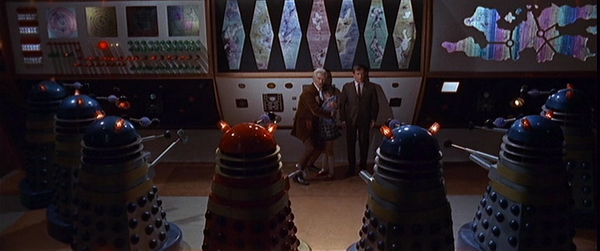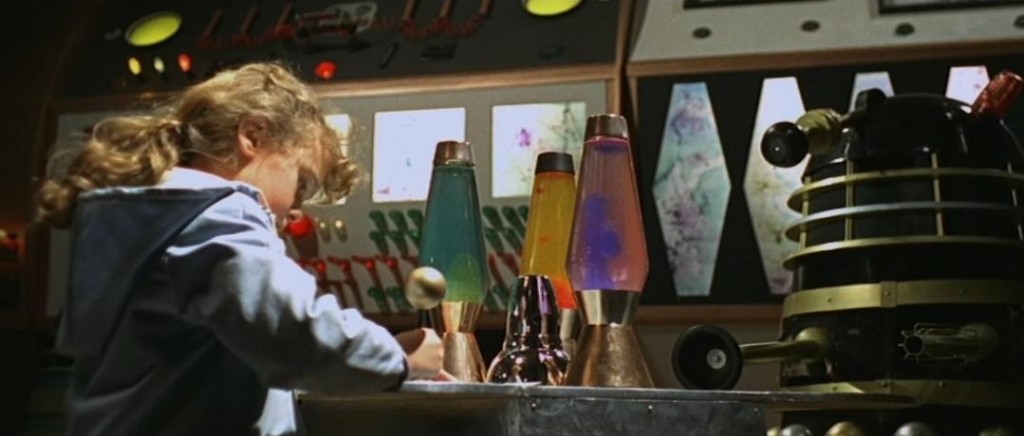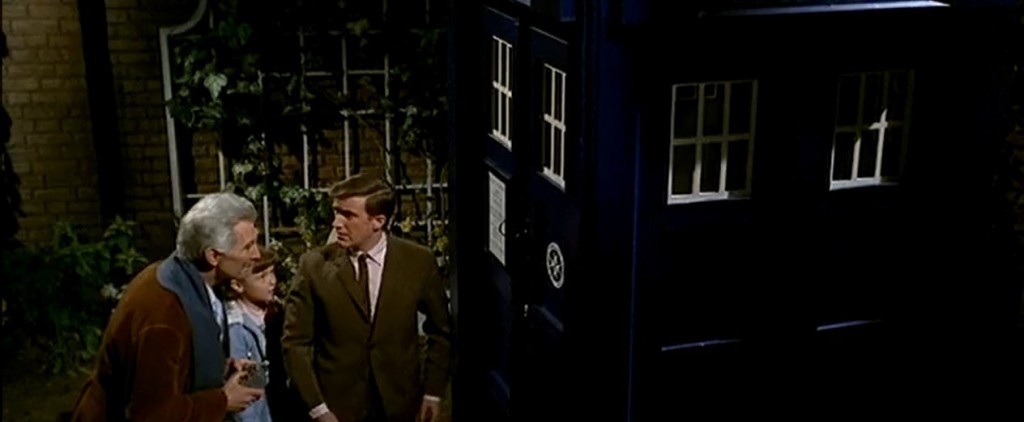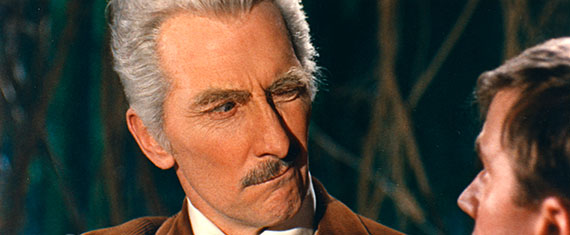As a member of the original Star Wars generation, I’ve always associated Peter Cushing, the venerable British stage and screen star, with a single role: Grand Moff Tarkin, the only Imperial authority other than Emperor Palpatine who gets to boss Darth Vader around. Many other moviegoers knew Cushing best from Hammer Films’ lurid Dracula movies. His turns as the vampire-hunting Van Helsing “catapulted Cushing… to near god-like status in the world of horror,” says Wendy Brydge at Seeker of Truth. Wendy also points out that Cushing played mad scientist Victor Frankenstein no fewer than six times—surely some sort of record.
Cushing’s career boasts an impressive number of highlights, many of which sound appealing to fans of the fantastic. But one of his most surprising science fiction roles was that of Dr. Who!
His two “Who” movies—Dr. Who and the Daleks (1965) and the awkwardly titled Daleks’ Invasion Earth 2150 A.D. (1966)—have inspired their own subset of Doctor Who fandom. For example, the films’ aficionados write, illustrate, and publish a yearly anthology of fiction called the Fannual. And no less a fan than current Doctor Who showrunner Steven Moffat tried to pull off a nod to these movies in “The Day of the Doctor.”
But even though these two films mark the only times (setting aside last November’s anniversary extravaganza) that the TARDIS has materialized on the silver screen, they don’t enjoy canonical status in Doctor Who lore. Some Who fans don’t even like them. Why not?
Colorful Daleks and Kid-Friendly Characters
Fans often dismiss these films as funny footnotes in Doctor Who’s history because the moviemakers aimed their work squarely at children. England’s kids went crazy for the Daleks when those malevolent mutants first trundled their way onto TV in December 1963. The monsters are the big draw here: larger, more detailed (some wield claws instead of plungers), and more numerous than they were in “The Daleks,” the TV serial on which the first film is based.
And the movie Daleks are in color! Freed from the confines of black-and-white television sets, they roll across the big screen in bold combinations of red, blue, silver, black, and gold. Even the Dalek city is colorful, from blinking lights on the walls to lava lamps (yes, lava lamps) on the tables. Considering the BBC didn’t begin regular color broadcasting until 1967, young Dalek fans must have loved every eye-popping sight of their favorite terrors in fantastic Technicolor.
Dr. Who and the Daleks aims for its true target audience in other ways as well. While the screenplay stays largely faithful to Terry Nation’s teleplay (likely due to the uncredited work of TV Who script editor David Whitaker), it lacks the original serial’s lengthy discussions of such subjects as pacifism and leadership—necessarily so, given a running time of 80 minutes as opposed to over three hours! It retains most of the peril from the televised version, but also introduces some comic relief. In his bumbling but likeable version of Ian Chesterton, Roy Castle proves the enduring value of a well-done pratfall.
All the characters differ from their TV counterparts in child-friendly ways. Neither Ian nor Barbara (played here by Jennie Linden) are teachers—no BBC executives worried about making sure children have proper authority figures to look up to—and Susan (more often called “Susie”) isn’t a teenager now. As played by Roberta Tovey, she’s about ten. She’s still a “whiz kid”—at one point, she rattles off time travel technobabble that would make Wesley Crusher’s head spin—but she’s not obnoxious. With her enthusiasm for science, eagerness to explore, and sense of humor, Susie strikes me as the kind of girl character we still need to see more today.
Duel of the Doctors
It’s Cushing’s character, however, that some Doctor Who fans dislike most, because he’s not “the Doctor.”
It’s true that, as far as we know, Dr. Who is no extraterrestrial in exile, but a slightly doddering human inventor actually surnamed “Who.” But he has a space-time machine named TARDIS (no definite article, as occasionally in the TV series’ early stories), housed in a blue police box that’s bigger on the inside. It takes him and his companions to an alien world where they wind up fighting Daleks. All things considered, isn’t Dr. Who more like the Doctor than unlike?
No! say detractors. Just last November, the British newspaper The Guardian called Dr. Who “a little bit rubbish… just a doddery, avuncular old man; light years from the mischievous, crotchety doctor of William Hartnell… Cushing does his best, but he’s not exactly given a lot to work with.”
I’m not arguing Dr. Who is a role equal to King Lear. And there’s no denying the Doctor is a far more fascinating character: a complicated protagonist cloaked in mystery, frequently short-tempered, fully capable of mischief and malice. Cushing’s character has no rough edges, no real flaws, no shadows. Dr. Who could not have sustained fifty years of dramatic television—but as a blend of Albert Einstein, Willy Wonka, and the Modern Major-General from The Pirates of Penzance, he’s the perfect person to introduce us to new wonders. “Young man,” he exclaims to Ian, after Ian accidentally activates TARDIS’ controls, “do you know what you have just done?… We could be anywhere in the universe, at any time!” After a beat, he adds, with a smiling twitch of his pursed lips, “Rather exciting, isn’t it?”
“Anyone Can Understand”
I think Dr. Who bests the Doctor in one important respect. It’s a fleeting moment in the movie, almost a throwaway line, but I think it sums up Dr. Who’s guiding philosophy: “Anyone can understand science if they put their minds to it!”
Even if the Doctor were not a Time Lord, I can’t imagine him saying such a thing. Yes, he sometimes has praise for humans, but he never doubts he is smarter than we are, and that he understands things we can’t. But Dr. Who is one of us, and if he can unlock the mysteries of space and time, there’s no reason we couldn’t and shouldn’t, too.
I find myself wishing the church said, more often and more loudly, something like what Dr. Who says. Anyone—including devout Christians—can understand science, if they put their minds to it—their God-given, powerful, amazing minds!
The sages of ancient Israel did, drawing lessons for life from their observations of the natural world (for example, Proverbs 6.6-11). King Solomon did, using his divinely granted wisdom to become an expert in botany and zoology (1 Kings 4.33). God created a world that is wild and wondrous, but “he did not create it a chaos” (Isaiah 45.18, NRSV). We may not ever discover all of creation’s secrets, but we have discovered so many of them, and have been able to enrich so many lives as a result.
Does scientific advancement carry risks? Of course, not least the risk of pride. We are not only imperfect but also fallen and sinful, and the sages rightly cautioned us to put ultimate trust only in God, not in our own understanding (Proverbs 3.5). But they did not mean we could never trust our ability to see, to think, to learn. God is the God of truth, and no truth—moral, theological, or scientific—can ever come, ultimately, but from him.
But these thoughts are far more serious, and far less entertaining, than anything you’ll find in Dr. Who and the Daleks. If you’ve never watched it, don’t let its critics keep you from giving it a try. If nothing else, as a self-respecting sci-fi fan, you don’t want to miss Peter Cushing’s brief tenure in the TARDIS. And you may just find this admittedly unusual adventure in space and time leaving you smiling like the children who thrilled to it almost fifty years ago.





Very nice piece, Mike! And thanks for linking to my posts! 🙂
Thanks, Wendy! And no problem!